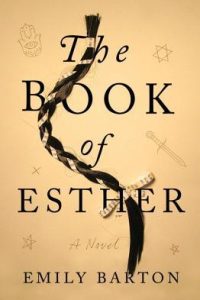 Years ago I read an article where the author asked why there wasn’t a “Jewish Narnia,” a fantasy story based on the Jewish religion, much like the Chronicles of Narnia are based on Christianity. I’m not sure if anyone else answered the call since then, but Emily Barton’s The Book of Esther comes close.
Years ago I read an article where the author asked why there wasn’t a “Jewish Narnia,” a fantasy story based on the Jewish religion, much like the Chronicles of Narnia are based on Christianity. I’m not sure if anyone else answered the call since then, but Emily Barton’s The Book of Esther comes close.
The Book of Esther is set in a world where the Khaganate of Khazaria existed up to the 1940s. For those who don’t know, the Khazars were a semi-nomadic Turkic people whose ruling class converted to Judaism in the 8th century. For a time they controlled a powerful empire that stretched across much of what we know of now as Ukraine, southwestern Russia and the Caucasus. In the 10th century, however, the rising power of the Kievan Rus captured the Khazar capital and ended their empire.
In The Book of Esther‘s timeline, however, this does not happen. By 1942 they appear to be a majority Jewish state (with a large minority of non-Jews) that is somewhat isolated and a bit backwards from the rest of the world. For example, slavery is still practiced and the Kagan, the leader of Khazaria, is kept hidden from his people and ritualistically killed after a certain amount of time into his reign. Additionally, although non-Jews have certain rights, they are by law second-class citizens.
Technology is also rather divergent in Khazaria. Modern Khazars tend to be farmers and merchants, relying on pigeons for long distance communication. There is very little industry and while they do export oil, most of the drilling and refining is handled by foreign Uyghurs, who also act as the criminal element in Khazaria. Meanwhile, there are few motorized vehicles in Khazaria with most Khazars preferring robotic horses, which are driven like motorcycles and actually have a surprising level of intelligence.
Now of course I need to discuss the fantasy elements of The Book of Esther (besides the robot horses). Werewolves are prevalent on the steppe and Jewish kabbalists create golem servants. These parts don’t bother me that much really. What does bother me is how little the world is different outside of Khazaria from our own history. Despite the existence of a large and powerful Jewish state in eastern Europe, most of this world’s history runs parallel to ours.
Although never named specifically, there exists a Nazi Germany and a Soviet Union fighting the same war they did in this timeline. Since we are looking at a point of divergence that must have happened at least 1000 years ago, I find it very unlikely that either nation could exist. It doesn’t help that the map that came with the book is full of anachronistic borders. For example, why does Poland have the borders it would have after World War II and what happened to places like Switzerland and the Low Countries?
 What I am trying to say is that The Book of Esther isn’t a very plausible alternate history, but what about the story? Well that is told from the perspective of Esther, a teenage daughter of one of Khazaria’s powerful ministers. She is about to be married soon to the son of the chief rabbi and, as far as arranged marriages go, she actually approves of the match and looks forward to the wedding…but she is concerned about the war back west. The Germans are pushing across Europe and driving Jewish refugees toward Khazaria with tales of mass slaughter. When the Germans cross the Khazarian border, bringing the war to them, she fears this could be the end of not just her nation, but her entire people.
What I am trying to say is that The Book of Esther isn’t a very plausible alternate history, but what about the story? Well that is told from the perspective of Esther, a teenage daughter of one of Khazaria’s powerful ministers. She is about to be married soon to the son of the chief rabbi and, as far as arranged marriages go, she actually approves of the match and looks forward to the wedding…but she is concerned about the war back west. The Germans are pushing across Europe and driving Jewish refugees toward Khazaria with tales of mass slaughter. When the Germans cross the Khazarian border, bringing the war to them, she fears this could be the end of not just her nation, but her entire people.
When Esther realizes that the adults are dismissive of her offers to assist with the defense of her country, she steals her father’s mechanical horse and rides north with her adoptive brother/slave, Itakh, to find the kabbalists to ask them to turn her into a man. Esther is convinced God wants her to lead her people in this war, but she knows they will only follow a male. The kabbalists, however, are either unwilling or unable to help with her request and Esther is about to give up until she talks with a kabbalist named Amit. He was originally a she who prayed to God to become male and had her request granted. Esther tries to duplicate the prayer…and fails.
Instead several kabbalists share a dream that convinces them to raise an army of golems to defend Khazaria. Giving Esther their existing golems she marches back home gathering an army of volunteers to fight for their nation. At first Esther’s father and the other ministers care little about Esther’s army, but with the enemy knocking at their gates, they may just be desperate enough to throw Esther and her unorthodox army into the fire.
Implausible alternate history aside, I enjoyed The Book of Esther overall. Our main character is likable without falling into the “strong independent woman” cliche. Although slow at the beginning, the pace of the book picks up about a third of the way in and keeps you interested in what happens next with its fantasy dieselpunk setting. Although I wished Barton spent a little more time fleshing out the rest of her world, Khazaria was nevertheless a well-designed fictional nation.
I did have an issue with the message of the book. Esther’s army is made up of the people with the least voice in Khazaria (women, slaves, heretics, criminals, refugees, etc.) who still want to be accepted by their homeland and want to prove their devotion to it by fighting for it. This works both with this timeline and our own. For example, Amit can be seen as a stand-in for transgender people and even the characters’ interactions with the golems seems to foreshadow our future relationship with artificial intelligence. That being said, at times I did sympathize with Esther’s father and the other leaders of Khazaria, despite the fact that I am pretty sure I wasn’t supposed to.
Throwing someone with little training into a combat situation is rarely a recipe for success. You see this a lot in fantasy stories, where a no-name peasant turns his life around and becomes the heroic knight, without needing the years of training since childhood most Medieval warriors had in our timeline. To the eyes of Khazaria’s leaders, Esther and her followers come off as misguided zealots with little to no discipline who can only be good as cannon fodder…and the critics are not far off. Although we know Esther has a higher power on her side, they don’t know that, and throwing civilians against machine guns, tanks and poison gas doesn’t seem like much of a plan.
That being said, I still think The Book of Esther is worth taking a look at. The alternate history is implausible and the message is a little iffy, but as a fantasy tale and an exercise in world building, it earns a recommendation. I don’t know if this is the Jewish Narnia, but it comes pretty darn close.










